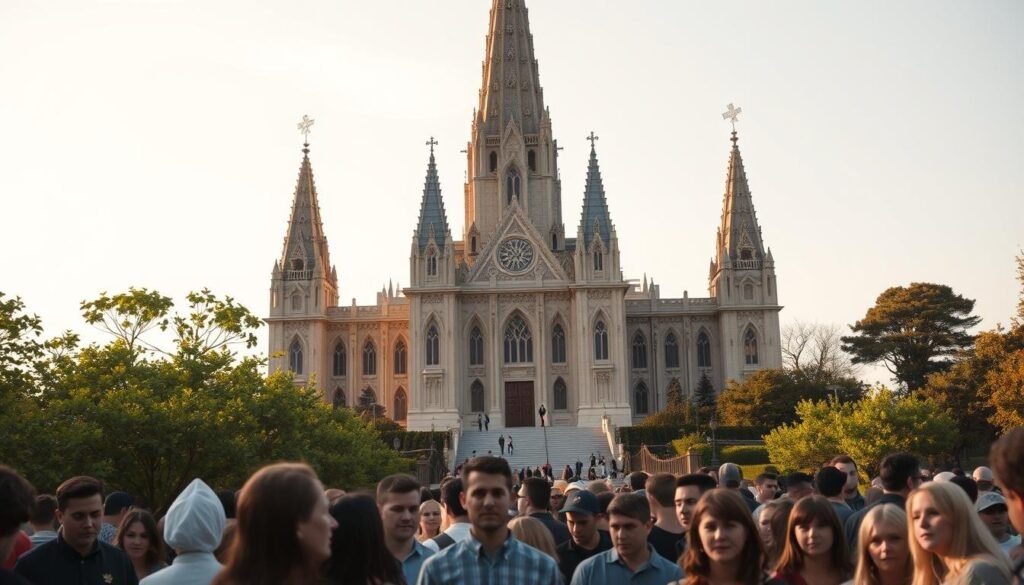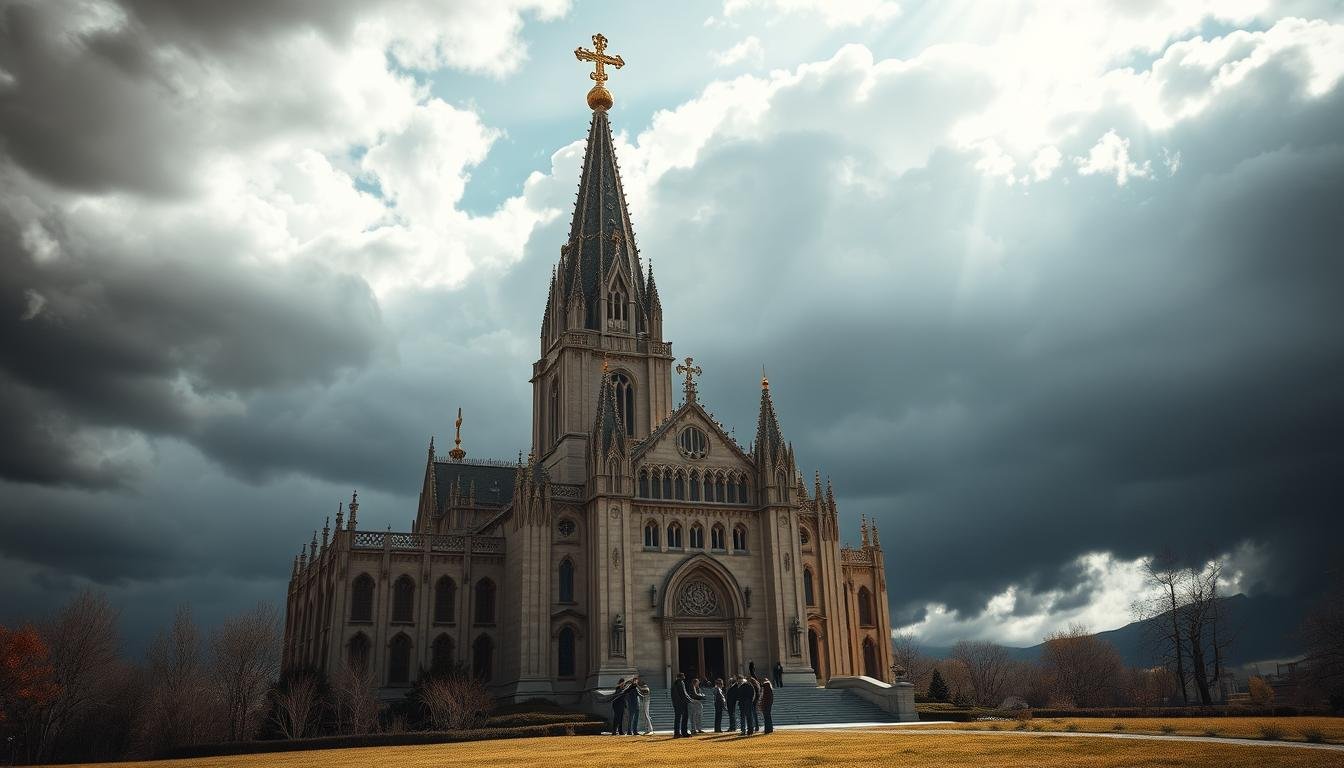Last updated on October 21st, 2025 at 05:46 pm
Is the Mormon Church Considered a Cult? Have you heard about the debate over the LDS Church, also known as the Mormon Church? People wonder if it’s a cult or a real religious group.
The LDS Church has sparked interest and debate. Its beliefs and practices are different from most Christians. As you learn more, you’ll see the different views on Mormon beliefs and what they mean.
To figure out if the Mormon Church is seen as a cult, we need to look at its history, teachings, and actions. This article will dive deep into the controversy. It will also share the various opinions about the LDS Church.
Contents
- 1 Understanding Religious Classifications
- 2 The Origins and Evolution of the Mormon Church
- 3 Core Beliefs and Practices of Mormonism
- 4 Is the Mormon Church Considered a Cult? Different Perspectives
- 5 Common Characteristics of Cults and Their Application
- 6 Mainstream Mormonism vs. Fundamentalist Offshoots
- 7 Controversies and Personal Experiences
- 8 Conclusion: Is the Mormon Church Considered a Cult?
- 9 FAQ
- 9.1 What is the difference between a cult and a sect?
- 9.2 Is the Mormon Church considered a cult by scholars?
- 9.3 What are some common characteristics associated with cults?
- 9.4 How does mainstream Mormonism differ from its fundamentalist offshoots?
- 9.5 What are some of the core beliefs of Mormonism?
- 9.6 How do Mormons worship and engage in community activities?
- 9.7 What controversies surround the Mormon Church?
- 9.8 Can former Mormons share their experiences?
- 9.9 How has the Mormon Church evolved over time?
Understanding Religious Classifications
Classifying religious groups is complex, shaped by history, society, and culture. You must look at their beliefs, practices, and defining traits. This helps in sorting them out.
Historical Context of Religious Classifications
In the past, some groups were seen as cults or sects for not following mainstream beliefs. Knowing this history helps us understand how these labels have changed over time.
| Classification Type | Characteristics | Examples |
|---|---|---|
| Cult | Often has a charismatic leader and unusual beliefs or practices. | Some new religious movements |
| Sect | A smaller part of a bigger religious tradition, with its own views or practices. | Various Protestant denominations |
| Mainstream Religion | Well-known and big religious organizations. | Major world religions like Christianity, Islam, etc. |
Understanding religious classifications means looking closely at different factors. This includes cult characteristics and sect definitions. The image below shows how complex these classifications are.
By studying the history and traits of different religious groups, we can better understand the wide range of religions out there. [Is the Mormon Church Considered a Cult?]
The Origins and Evolution of the Mormon Church
To understand the Mormon Church, we must look at its early days and the growth of its teachings. The Church of Jesus Christ of Latter-day Saints, known as the Mormon Church, started in 1830. Joseph Smith’s visions and messages led to a new religious movement that grew worldwide.
The teachings of the Mormon Church evolved over time. Smith’s visions and later leaders’ contributions shaped these teachings. Key ideas include ongoing revelation, the value of family, and eternal growth. These beliefs have influenced Mormon practices and identity.
| Year | Event | Significance |
|---|---|---|
| 1830 | Founding of the Church | Marked the beginning of the Mormon Church |
| 1844 | Death of Joseph Smith | Led to a succession crisis and the eventual leadership of Brigham Young |
| 1890 | Manifesto on Polygamy | Officially discontinued the practice of polygamy, a significant shift in Mormon doctrine |
Exploring the evolution of Mormonism shows the church has changed with society while keeping its core beliefs. Today, the Mormon Church is a global faith with a diverse community.
Core Beliefs and Practices of Mormonism
The Mormon faith, also known as the Church of Jesus Christ of Latter-day Saints (LDS Church), has unique beliefs and practices. These set it apart from other Christian denominations. At its heart, Mormonism values families, community service, and missionary work.
Worship and Community Practices
Mormons gather weekly in local groups, called wards or branches. They take part in sacraments, sing hymns, and listen to sermons. Community service is key, with members urged to volunteer and help others. Below is a table showing important practices and their role in the Mormon community.
| Practice | Description | Significance |
|---|---|---|
| Temple Worship | Mormons take part in sacred rituals and make covenants in temples. | Temples are seen as sacred places where members make promises with God. |
| Missionary Work | Young Mormons often serve as missionaries, sharing their faith. | Missionary work is a way to follow the command to spread the gospel. |
| Family Home Evening | Mormon families meet weekly for prayer, scripture study, and fun activities. | This practice helps families stay close and uphold Mormon values. |
Understanding these core beliefs and practices gives insight into Mormon life and community. By looking into these areas, we can learn more about the Mormon Church and its followers.
Is the Mormon Church Considered a Cult? Different Perspectives
Whether the Mormon Church is a cult is a complex issue. It involves both the views of those inside and outside the Church. Understanding the various factors that shape these views is key. [Is the Mormon Church Considered a Cult?]
Insider vs. Outsider Perspectives
Members of the Mormon Church see it as a real and vibrant faith. They highlight the Church’s focus on family, service, and personal growth. However, outsiders might see things differently, based on the Church’s history, practices, and teachings.

Scholars have different opinions on the Mormon Church. Some call it a cult because of its unique teachings and practices. Others see it as a distinct religious tradition. The table below shows some key differences between cult and non-cult views.
| Characteristics | Cult Classification | Non-Cult Classification |
|---|---|---|
| Leadership Structure | Authoritarian, centralized leadership | More democratic, decentralized leadership |
| Doctrines and Practices | Unique, potentially isolating practices | Diverse, inclusive practices |
| Community Engagement | Limited engagement with outside communities | Active engagement with diverse communities |
Looking at the Mormon Church’s status, we see that different views are important. By considering both insider and outsider perspectives, we can better understand the Church’s role in the religious world.
Common Characteristics of Cults and Their Application
To figure out if the Mormon Church is a cult, we need to know what cults usually look like. Cults have certain traits that set them apart from regular religious groups. [Is the Mormon Church Considered a Cult?]
Some common signs include a charismatic leader, a tight-knit community, and a push to keep members away from outsiders. They also often control their followers, have strange beliefs, and focus a lot on bringing in new members.
The Mormon Church, or LDS Church, has a rich history and unique practices. Looking at cult traits in Mormonism, we see some interesting points. For example, the church has a clear leadership, with a president seen as a prophet. This is similar to the leadership found in many cults.
Mormonism also values family and has a close-knit community. While this isn’t unique to cults, it’s worth looking into. The church’s history of isolation and some unusual beliefs, like past polygamy, are also important.
- A strong, centralized leadership
- A tendency towards exclusivity and isolation
- Unique beliefs and practices
By looking at these traits, we can understand if the Mormon Church shows cult-like qualities. It’s important to be careful in our analysis. Just because some traits are similar to cults, it doesn’t mean the whole church is a cult.
Mainstream Mormonism vs. Fundamentalist Offshoots
It’s important to understand the differences between mainstream and fundamentalist Mormonism. Mainstream Mormonism, led by The Church of Jesus Christ of Latter-day Saints (LDS Church), has changed a lot. It now takes more progressive views and fits well into American society.
On the other hand, fundamentalist Mormon offshoots have moved away from the mainstream. Groups like the Fundamentalist Church of Jesus Christ of Latter-day Saints (FLDS) still practice polygamy. This is something the LDS Church gave up in 1890.
The gap between mainstream Mormonism and its offshoots is big. Mainstream Mormonism is seen as a real religion. But, some offshoots act like cults, with strict rules and isolation.
- Mainstream Mormonism has moved away from practices like polygamy.
- Fundamentalist offshoots still hold onto these beliefs.
- How these groups are seen can change a lot depending on who’s judging.
When looking at the Mormon Church and its parts, remember these differences. How we see these groups affects our view of religion and society. [Is the Mormon Church Considered a Cult?]
Controversies and Personal Experiences
Exploring the Mormon Church reveals many controversies. These issues affect both members and outsiders. The Church of Jesus Christ of Latter-day Saints (LDS Church) has faced many challenges. These range from historical mistakes to social problems.
Personal Stories and Experiences
Many people have shared their stories about the Mormon Church’s controversies. Some have talked about the church’s past treatment of Native Americans and its stance on polygamy. Others have discussed their struggles with the church’s policies on LGBTQ+ issues.
The following table highlights some of the key controversies and their impact on personal experiences:
| Controversy | Impact on Personal Experiences |
|---|---|
| Historical inaccuracies | Some members have felt disillusioned upon discovering discrepancies in church history. |
| LGBTQ+ policies | Members of the LGBTQ+ community have reported feeling ostracized or unsupported by church policies. |
| Polygamy | Some individuals have struggled with the church’s past practice of polygamy and its ongoing implications. |
These controversies have shaped many people’s experiences. They have influenced how they see the church and its teachings. By looking into these issues, you can understand the Mormon Church’s complexities better.
As you delve deeper, consider the different views and experiences within and around the Mormon community. This will help you grasp the church’s impact on individuals and society more clearly.
Conclusion: Is the Mormon Church Considered a Cult?
You’ve looked into the Mormon Church’s status as a cult. You’ve learned about its beginnings, main beliefs, and practices. Whether the Mormon Church is seen as a cult is a complex issue with many views.
Mormon beliefs mix Christian teachings with unique ideas like the Book of Mormon and eternal progression. Some people see these as genuine faith, while others think they point to a cult. [Is the Mormon Church Considered a Cult?]
To decide if the Mormon Church is a cult, you need to weigh the evidence and opinions. The Church’s main activities and its fundamentalist groups have faced criticism. Personal stories also add to the debate.
Whether the Mormon Church is a cult depends on how you define a cult. By studying its history, beliefs, and actions, you can make a more informed judgment.
See Also: Do Mormons Celebrate Holidays and Birthdays?
FAQ
What is the difference between a cult and a sect?
A cult often deviates from mainstream norms, led by a charismatic figure. A sect, on the other hand, is a subgroup that splits from a larger religious group. This split usually happens over disagreements in doctrine or practices.
Is the Mormon Church considered a cult by scholars?
Scholars have mixed views on the Mormon Church. Some see it as a legitimate religion, while others call it a cult. This is due to its unique beliefs and practices, like early polygamy and temple rituals.
What are some common characteristics associated with cults?
Cults often isolate members, control their lives, and have unusual beliefs. They also have a charismatic leader. The Mormon Church has faced scrutiny for these traits, especially in its early days and among some offshoots.
How does mainstream Mormonism differ from its fundamentalist offshoots?
Mainstream Mormonism, or The Church of Jesus Christ of Latter-day Saints, has moved away from practices like polygamy. Fundamentalist groups still practice it. These differences shape how each is viewed in terms of cult characteristics.
What are some of the core beliefs of Mormonism?
Mormonism emphasizes families, eternal progression, and Jesus Christ. It also believes in continuing revelation, where the church president receives divine guidance. [Is the Mormon Church Considered a Cult?]
How do Mormons worship and engage in community activities?
Mormons attend church services and participate in temple rituals. They also do community service and value family activities. Family home evening is a key activity, where families pray, study scripture, and engage in other activities together.
What controversies surround the Mormon Church?
Controversies include historical polygamy, the church’s stance on LGBTQ+ issues, and criticism over its handling of history and finances. There are also questions about its transparency regarding temple rituals.
Yes, many former Mormons share their stories. They talk about the challenges of leaving, the emotional and social impacts, and their observations on the church’s practices and culture.
How has the Mormon Church evolved over time?
The Mormon Church has changed a lot. It moved from early practices like polygamy to becoming a mainstream Christian denomination. Today, it uses modern technology and focuses on humanitarian efforts.

Ramona Pearson from the USA is an experienced religious researcher and writer with over 10 years studying Mormon history, beliefs, and culture. She creates accurate, insightful content to educate and inform curious readers worldwide.

